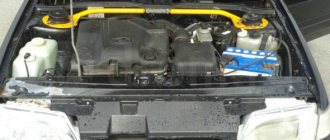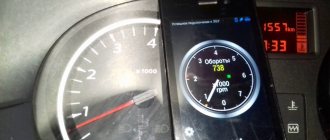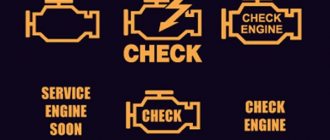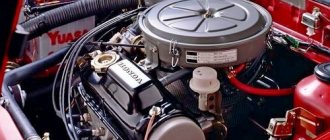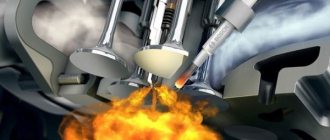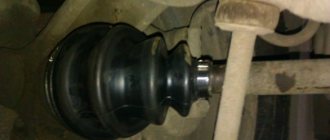The Solex carburetor is one of the main components in the fuel supply system, on which the efficiency of the entire vehicle depends. These carburetors are very popular today.
The main reasons for their popularity are fuel efficiency and high efficiency of your power unit. However, to achieve such indicators it is necessary to configure it.
Setting the float chamber level
First of all, you need to pay attention to the fuel level in the float chamber.
The adjustment procedure is as follows:
- It is necessary to start the engine and carefully apply gas to check the efficiency of the carburetor;
- Remove the air filter from the carburetor and the fuel hose.
- Unscrew the 5 bolts and remove the carburetor cover. Be sure to vertically so as not to damage its floats. Place this cover on a flat surface.
- When removing the carburetor cap, the fuel level should be at the red lines. The fuel depth must be measured. This figure should be about 29 mm. The procedure should be carried out immediately after removing the carburetor cap, since gasoline tends to evaporate.
- The height of the floats needs to be adjusted. We measure the distance from the cardboard gasket of the carburetor cover to the top of each float.
- The recommended figure is 34 mm. If necessary, you need to bend the levers and float tongue.
- Let's start adjusting the full stroke of the floats. The permissible lift of the lower angle of the float is 15 mm, and the full stroke of the float is 25 mm. Make sure that the edges of the floats are parallel to the sealing surface of the cover.
Signs of malfunctions
It should be noted that it is difficult to successfully resolve this situation without making the correct “diagnosis”. It is important to check all working components of the motor.
The following symptoms indicate poor carburetor performance:
- The Lada engine speed drops on its own, resulting in an unreasonable increase.
- There are gaps in the functioning of the cylinders.
- In the area of the carburetor and muffler, sharp pops periodically occur.
- At idle, the number of rotations is unstable, they have fallen.
The reasons for the drop in rotation at idle solex appear due to violations of the operating conditions of the vehicle. The manufacturer determines the rules for using the vehicle. Often, problems with the carburetor (idles float) are a consequence of unfavorable climate conditions (high humidity levels, high temperatures, changes). Do not forget to check the engine's performance in a timely manner.
Idle speed setting
After setting the level in the float chamber, we assemble the carburetor and warm up the car engine to operating temperature. In this video, they will tell you and show you how to set the idle speed in a Solex carburetor, as well as the main reasons for its absence.
Next, we turn it off and carry out the following operations:
- Using a flat-head screwdriver, tighten the mixture quality screw until it stops (position 7).
- We turn it back from this position 4 - 5 turns.
- We start the engine, do not forget to completely remove the choke, and using the mixture quantity screw (position 6) set the minimum engine speed to about 800 per minute so that the engine runs stably.
- We tighten the mixture quality screw until the engine starts to run unstably. Then we turn it back 0.5 - 1 turn, which should bring the engine to a relatively stable position.
- Using the mixture screw, set the engine speed to about 800 - 900 per minute. If the engine starts to stall, unscrew the mixture quality screw a little more.
When setting the idle speed, some problems may arise:
The engine does not slow down when the mixture screw is tightened (a lot of fuel gets into the idle channel and this screw cannot shut it off).
Causes:
- large jets installed;
- the solenoid valve is not tightly screwed in, and fuel is sucked past the nozzle;
- deformation of the nozzle seat or itself.
So, for example, if the engine stalls when removing the wire from the solenoid valve, this means that the jet is installed too large.
The VAZ engine does not work properly - why is repair needed?
Over time, almost every owner of a VAZ 2109 is faced with a problem such as a drop in engine speed at idle. Why can't I use a faulty machine? In this condition, operating the vehicle is problematic. At a traffic light, the car, when the speed drops, may suddenly stall or when the gear is engaged in neutral.
If such a situation arises, the VAZ driver must constantly support the car by pressing the gas pedal. This operation is performed so that the vehicle does not stall when the speed jumps at idle on the VAZ 2109 in the carburetor. When such a difficulty arises, the driver notices that the tachometer needle constantly symbolizes the presence of different revolutions. This figure ranges from
500-1200. The car is shaking, which additionally causes discomfort.
If you find that the idle speed of a VAZ 2109 in a Solex carburetor is floating, then you should not put off solving the problem. Due to such unstable functioning of the carburetor, other vehicle systems may also fail. And this will lead to the need for more expensive repairs.
Selection of jets
Some parameters of serial carburetors are far from the standard ones, since the dimensions of some parts have manufacturing deviations. An interesting and very useful video from which you will learn how to modify the Solex 21083 carburetor.
Thus, the spread in the parameters of some serial carburetor parts can reach up to 5%. Therefore, when adjusting the carburetor, make sure that the jets are in good working order. The selection of jets is carried out taking into account the working volume of the car.
If the engine has a large displacement, then it is necessary to install small jets, since an increase in volume requires more air passing through the diffuser, which affects gasoline consumption. Their adjustment should begin with the fuel jet, and then, if necessary, move on to the air jet.
You need to have several jets available with higher and lower productivity than the installed one.
Our actions:
- Using a wire, secure the throttle valve of the second chamber to eliminate its influence.
- Next, we select the jets, for example, the jet marked “107.5”, which is our basic one, change to “105”, and then “97.5”. We reduce the throughput of the jets until dips appear when the throttle is open or twitching when driving. When these signs appear, you should unscrew this jet and replace it with the previous one, which had a slightly higher performance.
- If dips occur when starting the car, you should enrich the mixture slightly by adjusting the idle system.
If you are trying to increase the efficiency of your car, then it is not recommended to reduce the flow area of the main fuel nozzle of the second chamber, since the acceleration process will be much longer, and all savings will be reduced to zero.
Signs of failure in the fuel system
The presence of possible malfunctions in the operation of the vehicle’s power system can be judged by the characteristic signs of the vehicle’s behavior on the road:
- Failure - while pressing the gas pedal, the car continues to move at the same speed (or deceleration) for a short period of time (from 1 to 30 seconds), and only after a while begins to pick up speed;
- A jerk is reminiscent of a failure, but it is more short-lived;
- Rocking - periodic failures;
- Twitching is several jerks that follow each other;
- Sluggish acceleration is a reduced rate of increase in vehicle speed.
Adjusting the accelerator pump
Accelerator pump metering systems
The main task of the accelerator pump is to supply a smooth and powerful stream of gasoline through the open throttle valve of the carburetor (dripping and sluggish streams are not allowed). The stream of gasoline should enter directly into the manifold, without touching the walls of the diffuser and throttle valve.
Flowing of gasoline down the diffuser stack or throttle valve is not allowed, since the car will become very blunt and jerky when you press the gas sharply.
An accelerator pump with two spouts must be installed in different chambers. You can insert two spouts into the primary chamber - this can increase the agility of the car, but also lead to excessive “overflow”.
Procedure: from simple to complex
The simplest solution is to sell the car. Maybe this is the best decision. When your car has a high mileage and service life, and you are not a professional auto mechanic, then there is no point in undertaking repairs. If you are not very strapped for money, if numerous “unreasonable” breakdowns occur, perhaps the best solution is to exchange the VAZ 2109 for a simple used foreign car or a new Lada.
But if you decide to tinker with your Samara and adjust the idle speed yourself, start with simple things. Inspect the electrical wiring, inspect the contacts, touch the connector pads. The causes of floating faults often lie in the vehicle's electrical wiring. It gets hot and dry - there is contact, gets wet and cools - there is no contact.
If, when moving the wires under the hood, a malfunction appears and disappears, start ringing the wires one by one. Particularly vulnerable in the “nines” is the harness that leads to the fuse box. It is located next to the drain coming from the windshield, and during precipitation it gets wet more intensely than others.
Among other simple things that can cause the 9's engine speed to fluctuate at idle is a clogged air filter. This applies to both carburetor and injection versions of the power plant. It's easy to check.
Setting the transient mode of carburetor operation
At idle speed, the carburetor throttle valves close and a high vacuum area is created under them, which allows gasoline to be “sucked” out of the idle channel through the nozzle. If the damper is opened sharply, the vacuum decreases sharply, which disrupts the normal operation of the main dosing system of the first chamber and a failure appears.
To eliminate these symptoms, adjust the idle jet or accelerator pump nozzles. The adjustment must be made on a warm car engine.
The idle jets or accelerator pump are changed one by one to prevent dips and delays when you press the gas sharply.
You may need to adjust the idle speed a little. Over-enrichment is not transiently displayed as black smoke coming from the exhaust pipe.
Do-it-yourself interior tuning. How to do this and what is needed for this can be found on our unique website.
From here, you can learn how to do tuning a Chevrolet Niva with your own hands.
In this informative article, you will learn how to polish a windshield with your own hands.
It is recommended to install an accelerator pump with 40x40 nozzles, and an idle nozzle with parameters from 35 to 40. If there are dips from a lean mixture and it is not possible to adjust the idle speed due to the idle nozzle being too large, then both accelerator pump nozzles can be placed in the first camera as shown in the picture.
Carburetor speed fluctuates
You rarely see imported components on domestic cars. Basically, AvtoVAZ engines are equipped with a Solex or Ozone carburetor. Less often you can find products from the Dimitrovgrad Aggregate Plant, known for its reliability: the DAAZ carburetor. Drivers of relatively modern cars, accustomed to the check engine light, can easily determine any malfunction using an on-board computer or an inexpensive car scanner, but for veteran engine owners, only hardware diagnostics are available.
A common malfunction is idle speed floating, the main symptoms are:
- It would seem that the problem does not affect the speed - with intensive use of the gas pedal, the malfunction is invisible. However, it is dangerous in traffic jams, when the engine may suddenly stall, and when engine braking on a long descent;
- In addition, increased vibrations do not add life to the motor and attachments. Bearings of rotating shafts experience axial loads that are not typical for them. And it is uncomfortable for passengers to be in the car when the tachometer needle jumps from 500 to 1500 rpm.
Setting up a second camera
As a rule, the second chamber of the carburetor is not adjustable, since all the shortcomings of the factory jets are compensated for by the econostat. The fact is that at high speeds, when a vacuum occurs in the carburetor, additional gasoline is supplied through the econostat, which makes it possible to enrich the mixture.
Only the accelerator pump nozzle can be adjusted if its jet does not fall between the diffuser wall and the throttle valve.
All of the above techniques for tuning the carburetor are basic in its regulation, however, some craftsmen can additionally drill channels and throttle valves, and solder epulsion tubes.
The Solex carburetor (DAAZ) is one of the most popular devices in the list of carburetor metering systems, since with the right approach it is possible to flexibly configure carburetors of this type. For this reason, car enthusiasts install Solex carburetors on different engines, after which they are further adjusted, achieving the required fuel efficiency indicators, quality of mixture formation at power and other operating modes of the internal combustion engine.
After installing Solex on the engine, it is often necessary to configure this device. To solve the problem, you can contact a service center, where a specialist in setting up the carburetor will perform all the necessary operations. You can also adjust the carburetor yourself. In this article we will talk about how to adjust the quality of the mixture on a Solex carburetor, how to adjust the fuel level and adjust the float chamber of the Solex carburetor, adjust the idle speed, etc.
Read in this article
Carburetor VAZ 2109: how does it work?
All VAZ “eights” and “nines” were equipped with domestically produced Solex, which are classified as emulsion-type units.
This internal combustion engine power supply mechanism has two chambers and a sequential throttle valve opening circuit.
He has:
- two main dosing systems;
- an idle mechanism and a transition system of the first chamber, equipped with a shut-off solenoid valve;
- diaphragm starting device;
- transition mechanism of the second chamber;
- accelerator diaphragm pump;
- power mode economizer;
- econostat.
Also, the car carburetor we are considering has an idle economizer, which is forced to start.
It consists of:
- a screw switch, which is designed to adjust the idle mixture volume;
- control unit (electronic);
- shut-off valve;
- a set of wires connecting all specified elements of the system.
The carburetor is installed using four studs on the intake pipe. Secure it with nuts. Opening is carried out using a pedal located in the car interior. A cable in a special sheath is attached to its upper part, which allows you to control the dampers. And using a handle located in the vehicle interior under the dashboard, the air damper is controlled.
Solex carburetor: setting and adjustment
Before starting the setup work, if it is necessary to adjust the carburetor air damper, the fuel level in the chambers, setting the idle speed and other manipulations, it is necessary to separately study the design of the carburetor system, the location of the jets and other basic elements (econostat, economizer, float, first and second chamber, dampers, etc.) You should also pay attention to how the cover is removed and the carburetor is disassembled.
You need to start setting up by setting the fuel level in the float chambers. The recommended method is to set the specified level according to the position that the floats have in relation to the carburetor cover. All manipulations are carried out using a separate template. Note that, as practice shows, this method cannot in any way be considered optimal, since when installing Solex on a car, it should be taken into account that the fuel pump on one specific vehicle may differ from the fuel pump on another car. There may also be other differences in the power supply system. The result is that the pressure on the carburetor needle (carburetor shut-off valve) is also different. Most often, after tuning according to the template, fuel enters the carburetor in large excess. In order to accurately set the gasoline level in the carburetor and adjust the Solex carburetor float successfully, you must follow the steps described below.
- Usually, immediately after installing Solex on different internal combustion engines with different displacements, even without preliminary adjustments, the engine should still start. The engine must be started, after which the power unit should run for about 10 minutes. When running at idle, you can lightly press the gas and increase the speed to avoid the engine shooting into the carburetor or exhaust system.
- Then the power plant can be turned off, after which it is necessary to remove the fuel supply hose. It is recommended to prepare a rag to remove any remaining gasoline that splashes after removing the said hose. The hose is removed so that after removing the carburetor cap, gasoline, which is under pressure in the hose, does not spill into the carburetor chamber. In other words, excess fuel entering the chamber can interfere with the accuracy of the measurements.
- Now you can unscrew the screws securing the carburetor cover, then you need to remove the cable that controls the “choke”. The next step is to carefully lift the carburetor cover. The specified cover should be lifted in a strictly horizontal position so as not to cause damage to the floats themselves.
- Next, you should prepare a ruler or caliper. With these tools you need to measure the distance that is obtained from the fuel itself in the chamber to the adjacent surface of the carburetor cover. The indicated distance from the surface of the cover to the surface of the fuel should be about 2.5 cm. We add that the distance must be measured in both chambers. This distance may vary, taking into account that the collector is not in a strictly horizontal position. Based on the difference in distances in both cameras, an average value is selected.
If no drops of fuel were noticed, then all that remains is to re-measure the fuel level in the chamber using the already known method. If the result is positive, this part of the setup can be considered complete. If the level again differs from the norm, then the level should be adjusted again. Note that setting the level with the engine turned off during manual pumping is not correct, since after starting the internal combustion engine the carburetor will still overflow, especially on engines where the return line has been blocked.
Solex carburetor: idle speed adjustment
The next step after adjusting the fuel level in the carburetor float chamber is to adjust the idle speed. To set up, you must first warm up the engine until it reaches operating temperature. After warming up, the unit should be turned off.
At the very beginning, you need to find the air-fuel mixture quality screw, which is rotated using a flat-head screwdriver. The specified screw is located in the hole, which is made in the lower part of the carburetor.
- The quality screw must be tightened until it stops. Screwing is carried out clockwise, and there is no need to apply force, as the thread can be damaged. After the screw stops, you should turn it back from the stop position by 4-6 turns.
- Now the engine should be started, the choke should be removed. Then you should set the minimum permissible speed by turning the quantity screw. Such minimum speed can be considered an indicator when the engine operates stably and steadily. Also, the vacuum in the vacuum advance fitting should be minimal. A fairly simple way to determine the vacuum is to close the tube that goes into the so-called vacuum advancer with your tongue. If the idle speed is in the range from 600-1200, the carburetor is fine.
- Next, the quality screw must be slowly tightened until the operation of the unit begins to lose stability. As soon as the engine begins to operate unstably, you should unscrew the screw back one or one and a half turns, catching the position when the motor is operating stably again
- We return again to the quantity screw, with which the idle speed should be set to 800-950 rpm. We set the speed screw at XX to about 850-900. If the engine stalls when setting such speeds, then you need to unscrew the quality screw.
- The quality and quantity screws are adjusted until the required idle speed is set, the vacuum in the advance tube will be minimal, and the internal combustion engine itself will be able to operate stably.
This problem arises for a number of reasons. First of all, a large idle jet can be installed. You should also pay attention to how tightly the solenoid valve or plug is screwed in. If the fit is not tight, excess gasoline may be sucked in bypassing the idle jet. Also, one should not exclude possible problems with the jet itself, as well as with its seat. To more accurately understand the reason, you will need to remove the solenoid valve wire with the engine running and idling. In this case, after removal, the unit should quickly stall. If this is the case, then the cause is most likely a large idle jet. The solution will require installing a smaller jet.
If the engine does not stall after removing the wire from the valve, then this problem may arise as a result of gasoline overflowing into the float chamber. It is also possible that when the internal combustion engine is running, fuel bypasses the jet or even the entire idle system. First of all, we again check that the level in the float chamber is set correctly. If everything is normal with the level, then the solenoid valve/plug should be unscrewed, after which you need to inspect the nozzle and its installation location. There should be no defects. If there are any, then the carburetor cap may need to be replaced. If no defects are found, then the jet is put on the valve, the O-ring is lubricated with engine oil, after which it is tightened with a wrench without effort.
How to set up a VAZ carburetor
Unstable idle mode (XX)
. If after starting you hear popping noises in the muffler, it means the exhaust system is clogged. In this case, it is necessary to unscrew the XX jet and inspect its integrity. A nozzle is considered to be working properly if all three holes on its head are round. If the shape is oval, the jet must be replaced.
If, after inspection, the nozzle turns out to be operational, you should remove the head and check the cleanliness of the pusher, which blocks the flow of fuel through the valve. The head itself has a calibrated hole. It has a very small cross-section and gets clogged quickly. We clean this hole well and then rinse the head.
After this, we check the condition of the rubber seal that is placed on the nozzle. If necessary, the rubber band should be replaced. After this, screw the nozzle into place without applying much effort.
Setting up EPHH
. If the engine stalls when the gas pedal is suddenly released, while everything works fine when it is released smoothly, it is necessary to check the functionality of the EPH system. First of all, it is necessary to assess the condition of the contact between the wire and the XX jet, which often oxidizes. If necessary, clean the contacts. We remove the tip of the wire and tighten it so that the connection of the wire to the nozzle is reliable.
Overfilling or underfilling of fuel
may be due to incorrect fuel mixture adjustment. This is determined by the “jerking” of the car when braking or accelerating. To eliminate this problem, you need to remove the top part of the carburetor by unscrewing 5 bolts. Then we turn the top up and check the condition of the floats. They should be installed parallel to the two marks that are on the carburetor gasket on the right and left.
Following this, we set the fuel level in the carburetor. For the VAZ-2109, the optimal level is 37.5 mm. This distance is measured from the top of the floats to the gasket. In this case, the lower edge of the floats will be at a distance of 5-6 mm from the gasket.
Note
. In the carburetor instruction manual, for some reason this distance is indicated as 1-2 mm. In practice, with this position of the floats, the fuel mixture always overflows and the engine “chokes.”
We set the required level by bending the float holder. But you need to be careful not to move the floats themselves under any circumstances. After setting the required level, we check the position of the floats again. They must be installed perpendicular to the gasket.
Cleaning of the main dosing system is carried out when the car “twitches” or accelerates weakly while driving. Most often, the first chamber of the carburetor becomes clogged. First, unscrew the air supply jets. As a rule, they are always clean. First of all, the fuel jets, which are located under the air jets, become clogged. Using a small flat screwdriver, you need to unscrew the jet and clean it. The easiest way to blow into a calibrated hole is with a syringe.
Note
. In the case of floating XX, some drivers resort to a radical method of troubleshooting. Considering that they have tried everything and nothing helps, they remove the core (tip) of the XX jet. As a result, the fuel mixture will be enriched. Because of this, we get black spark plugs and additional deposits in the combustion chambers. Experts do not recommend removing the jet tip. It must first be cleaned or replaced with a new device. Remember, if the XX jet is working normally, the engine in XX mode should stall when the wire is disconnected from the jet contact.
Jets and accelerator pump
Owners of carburetor cars know that jets change, but they do not always understand why jets are needed and how their size affects the operation of the carburetor. Let's start with the fact that the engine sucks in air through a special hole made in a large diffuser. At the same time, a certain amount of fuel is drawn through the fuel nozzle. The engine displacement directly affects how much air the engine will draw through the diffuser in a certain time, as well as the amount of gasoline sucked in parallel with the air.
Now let's talk about the accelerator pump. The accelerator pump delivers additional fuel when the throttle valve opens, allowing for more efficient acceleration. The pump is activated using a special cam. On engines with a Solex carburetor installed, the indicated accelerator pump cam must be set to the largest one.
You should also pay attention to the so-called “spout” of the accelerator pump. When the valves are opened, fuel should flow in a clear stream and not drip even with a slight throttle opening. It is also important what position the nose occupies. The stream of gasoline must fall exactly into the area between the diffuser wall and the throttle valve, that is, the fuel is jetted directly into the manifold. The jet must not hit the diffuser or damper. If this happens, then after sharply pressing the accelerator pedal the car will not accelerate immediately, and a failure will occur. Self-refinement of the carburetor involves installing two spouts in the chambers to obtain better performance from the engine, or only one spout in the first chamber of the carburetor for a more economical mode.
Carburetor jets VAZ 2109
These system elements are presented in two types. They can be:
- air;
- fuel
In terms of their effect on the quality and composition of the fuel mixture, they are opposite:
- depletion of the mixture is fixed when the cross-sectional area of the air jet increases;
- enrichment is noted as the cross-section of the fuel nozzle increases.
Moreover, the level of their influence depends on the specific operating mode of Solex.
The composition of the combustible mixture is regulated in direct proportion to any throttling modes by the cross-section of the fuel nozzle. But the impact of its “brother” is more noticeable with an increase in the throttle opening angle.
Carburetor transition setting
While the engine is idling, the throttle valves are closed. A vacuum (vacuum) is formed under the dampers. Thanks to this vacuum, gasoline is sucked out through a small idle channel and nozzle, and the engine itself runs smoothly at idle. If you open the damper sharply, then the vacuum also weakens. Moreover, this vacuum is not enough for normal operation of the MDS (main dosing system) in the first chamber, and the idle system and accelerator pump are not yet capable of normalizing engine operation. In other words, when you sharply press the gas after idling, there is a delay in the response to pressing the accelerator pedal.
To minimize or completely eliminate this failure, a transition system is used in the carburetor device. This diagram is a hole-slot made above the throttle valve in the first chamber. At the moment you press the gas pedal, the slot-shaped hole appears in a zone of high vacuum, due to which intensive fuel suction occurs parallel to its supply through the idle jet.
Let's go back to the settings. After the carburetor has been installed, many cars experience a failure when starting from a stop, reactions to pressing the gas pedal are slow, and the engine may start shooting at the carburetor or stall. In such a situation, the transition system may be to blame. In order to normalize the operation of the carburetor, it is necessary to correctly select the cross-section of the “spout” of the accelerator pump and the size of the idle jet.
It is important to know that the nozzles in the first chamber do not need to be touched, and the indicated failures should not be attempted to be eliminated by replacing the nozzles of the main dosing system. To solve the problem, use a previously built carburetor to correctly select the idle jet and the accelerator pump spout. The selection must be made after the internal combustion engine has warmed up, the choke must be removed.
In practice it looks like this:
The level in the float chamber was previously set and the idle speed was adjusted. A warm engine idles normally without chugging. A stream of gasoline from the accelerator pump nozzle hits the manifold. Now you can sharply press the gas pedal. What is needed is the sharpness of the press, and not how hard the pedal was pressed (to the floor, half a stroke or ¼). Normally, the motor should immediately respond and spin up, that is, the speed increases without delays or failures. If the response to a sharp press on the accelerator is slow or there is a noticeable pause before the speed increases, then you should go to the settings.
To accurately determine the cause, you need to press the gas pedal again, but this time smoothly and not sharply. If in this case there is an even increase in speed (without pauses, dips or delays), then you should pay attention to the idle jet and the pump spout, since the main dosing system has nothing to do with the failure. If, when you gently press the gas, the engine spins up poorly, the unit itself begins to work jerkily, hums, vibrates strongly, etc., then the problem lies in the selection of jets for the first chamber. In other words, excessive enrichment or leanness of the mixture occurs after the carburetor switches to power mode after pressing the accelerator. An indirect sign of a too “rich” mixture during operation in transition mode is that the engine emits black smoke and the smell of gasoline comes from the exhaust system. The specified smoke and smell appear after sharp throttling.
To remove the dip, you must carefully select the idle jets to match the pump spout or vice versa. This is done until the delay disappears when you sharply press the accelerator pedal. In parallel with this, it may be necessary to re-adjust the idle speed, since replacing the XX jet will make changes to the operation of the idle system. Let us add that if the mixture remains lean and there is a dip, and the idle jet is too large and it is not possible to adjust the idle speed, then you can install a paired pump spout, after which both tubes are bent into the first float chamber.
Design and principle of operation of the solenoid valve
The solenoid valve, also called the forced idle economizer (IAF), is an integral component of any carburetor in modern cars. The active use of this unit began in the 80s of the last century, when the “battle” between injection and carburetor units intensified. This is largely due to the fact that the former had noticeably lower fuel consumption, and this already captivated a larger number of motorists.
In order to minimize the consumption of carburetor engines, automotive engineers began to actively electronize them. In a few words, the essence of the latter was to reduce fuel consumption through the use of electronic devices. As a result, electronization resulted in the appearance of a carburetor solenoid valve, as well as a number of other electrical devices in the design of this unit. But why was this necessary and how did it help the competition between carburetor engines and injection engines? In order to answer this question, it is worth paying attention to the operating principle of the EPH.
So, the carburetor solenoid valve is a device that runs on electric current and performs very specific functions. More precisely, it works to organize stable and optimal idle speed in the so-called forced mode of engine operation. The essence of the optimization is that when the engine operates in modes that do not require fuel consumption (switching to a lower gear, coasting, etc.), the EPHH turns off its supply without involving the throttle valve in the movement at all. This happens by transferring fuel through special channels at idle. During this transportation, only the idle jets, valves and some paths in the carburetor function, that is, its chambers and throttle valve are completely inactive.
As a result, we succeed:
- firstly, save fuel when the engine operates in the previously noted forced running mode;
- secondly, organize a stable and optimized idle speed;
- thirdly, to ensure high-quality and problem-free engine warming up for the driver during startup (by increasing the fuel supply with the same EPH);
- fourthly, eliminate unnecessary functioning of the throttle valve and a number of other components in the carburetor;
- and fifthly, optimize the operation of the entire motor, which significantly extends its service life.
Note that the economizer operates under the control of a special unit called the “carburetor solenoid valve control unit.” This device constantly analyzes the operation of the motor, based on sensor readings (speed, engine temperature, etc.), after which it gives appropriate instructions directly to the EPHH, and it, in turn, through the movement of the rod (small needle) either closes to the desired position fuel supply channels at idle, or vice versa, opens them. In general, there are no particular difficulties in a working economizer, which is clearly shown by the description of the device presented above. For even greater clarity of everything described, we recommend that you familiarize yourself with the following pictures:
Adjusting the second chamber of the Solex carburetor
Let's start with the fact that when adjusting the carburetor, the second chamber is usually not touched, since often standard jets will be sufficient. The carburetor also has an econostat that can correct possible nuances. The econostat is a tube located in the second chamber at a slight angle.
The purpose of the econostat is that when the throttle is fully opened, the vacuum in the carburetor allows fuel to be sucked through the econostat. The econostat is activated when the engine is running at high speeds and allows the fuel-air mixture to be enriched. To refine the second chamber, which allows for “pick-up,” jets are installed to enrich the mixture. The selection of jets in this case is no different from the selection for the first chamber.
Determining the cause of the problem in the engine
In order to eliminate the reason why the carburetor on a VAZ 2109 has floating speed at idle, you need to know exactly the specifics of the breakdown.
The main culprits of the problem are:
- Air flow from outside into the carburetor (suction). This phenomenon occurs if the tube leading to the body of the vacuum-type regulator has come off or its diaphragm is damaged. Also, such a situation as suction appears when the hose from the brake booster to the manifold is damaged. Air can penetrate if the carburetor seating is deformed. These phenomena contribute to the “suction” of air, which leads to mixing of fuel and subsequent malfunctions in the functioning of the engine. The spins are jumping.
- There is a malfunction in the forced idle system - it jumps and falls. If this system fails, a breakdown occurs such as a failure of the valve needle to function. The passage in the fuel nozzle is completely or partially blocked. Such a malfunction leads to idle speed fluctuating and the VAZ 2109 carburetor stalling.
- The ignition system is faulty. It is necessary to check the functionality of the spark plugs. Their condition is easily diagnosed based on external data. Damaged items must be replaced with new parts.
- Burnout of the gasket located in the cylinder block. This malfunction causes the working fluids and gases to mix with each other. This leads to the normal functioning of the engine being disrupted due to the unstable action of one of the cylinders.
- Failures in the phases of distribution-type mechanisms. To clarify the presence of this breakdown, it is necessary to diagnose the position of the installation marks and the gas distribution system. You will also need information about the timing belt tension, since belt misalignment is one of the reasons that the VAZ 2109 carburetor gives speed that floats or jumps on suction. The engine stalls.
- Valve burnout. You will need to carefully inspect the engine compartment area. If you detect a loose wire, an unstable position, or a chip that is not fully tensioned, it is necessary to correct the problem. Why? With such failures, the engine is not able to function in normal mode, and the speed of the VAZ 2109 carburetor floats. The Solex engine stalls.
- The VAZ carburetor was adjusted incorrectly. The state of the mixture is regulated by the position of the screws. Thanks to them, the system is supplied with a “combined” combustible mixture. If the adjustment is incorrect, a failure in this process occurs. It can be eliminated by proper adjustment.
If dirt is found in the carburetor engine, then the likelihood of malfunctions is high:
- Blockage in the area of the fuel and air jet of the cold running system. The failure can be eliminated by cleaning the fuel and air jets. To solve this problem, the carburetor cover is dismantled.
- Solex air valve is dirty. If the level of contamination is high, then it is appropriate to replace this element with a new one. The unstable motion will disappear, the swimming will disappear.
- There is a blockage in the fuel system filter. When a large amount of contaminants accumulates, an effect such as floating idle speed on a VAZ 2109 often occurs.
Let's sum it up
The steps described above for setting up and adjusting a Solex carburetor are basic. In other words, if you wish, you can adjust the carburetor yourself, based on this information. Note that the accuracy of the settings can be further checked on a gas analyzer, after which you can make the necessary adjustments yourself instead of constantly contacting specialists. Finally, we add that a dosing device of this type lends itself to various types of tuning, all kinds of modifications and improvements. For this reason, when choosing a carburetor for a VAZ, it is not for nothing that many car enthusiasts prefer Solex.
One of the most popular operations in servicing Solex carburetors 2108, 21081, 21083 is cleaning the idle system. Clogging of the channels and jets of the idle system usually leads to such a malfunction in the carburetor engine of VAZ 2108, 2109, 21099 cars as unstable idling (engine troits) to its refusal to idle at all or the impossibility of adjusting it.
If suspicion falls on the idle system, then there are several ways to put it in order by cleaning the channels and jets.
Method one
In-place, without the use of special tools, devices and equipment.
— Remove the air filter housing
Disconnect everything shown in the image and remove the filter housing.
Removing the engine air filter housing on VAZ 2108, 2109, 21099 cars
— We start the car engine, set the “choke” speed to 2500-3000 rpm — Using a 13 mm wrench, turn the carburetor solenoid valve three or four turns
If the engine begins to stall, we rev up the throttle by hand rotating the throttle valve drive sector of the first carburetor chamber clockwise. The duration of the operation is 10-20 seconds.
EMK carburetor 2108, 21081, 21083 Solex
— Turn the solenoid valve back on and see if the engine idle speed has stabilized
If not, we repeat the action again and maybe again until we achieve a stable idle. Did not help? Let's move on to the second method.
Method two
It is necessary to completely unscrew the carburetor solenoid valve, remove the fuel nozzle from it and blow it out. Which is what we do.
disassembled carburetor solenoid valve
Next, it is advisable to purchase an aerosol can of carburetor cleaner or, at worst, a little acetone.
aerosol carburetor cleaner
— Fill (inject an aerosol) with a syringe into the mounting hole a little cleaning agent
mounting hole for EMC in carburetor cover 2108, 21081, 21083 Solex
— We wait a couple of minutes
- Start the engine and pull the choke handle towards you so that it can idle without a valve
— Let’s rev up a little and turn off the engine
We close the solenoid valve and enjoy the smooth idling of the engine. If there is no idle again, we repeat the operation again and maybe again, there is no point anymore.
It is understood that during such cleaning, as well as cleaning in the first way, all the dirt from the channels of the idle system of the carburetor 2108, 21081, 21083 Solex will be washed out and carried away by the strong vacuum caused by unscrewing the valve and increased engine speed, somewhere in the combustion chambers, where will disappear without a trace.
Didn't meet your expectations? Let's move on to the third method, maybe it will help us.
Method three
You will have to remove and partially disassemble the carburetor.
— Remove the cover (upper part) of the carburetor (it is assumed that the air filter housing has already been removed)
— Remove the carburetor body from the intake manifold
The process of removing the 2108, 21081, 21083 Solex carburetor is described in detail on the page “Removing the 2108 Solex carburetor from a car engine.”
— We clean the mounting hole (socket) of the solenoid valve in the carburetor cover with a thin wooden stick or thin copper wire
In addition, we clean the holes in the fuel channel CXX, the air channel CXX with the air jet built inside it. In the images, wooden sticks are inserted into the cleaning areas for clarity.
holes in the Solex carburetor cover that need to be cleaned
— We also clean the hole in the fuel mixture quality screw
hole for the “quality” screw of the fuel mixture in the Solex carburetor body
The screw must first be unscrewed. Before turning it out, we first turn it all the way and count the number of revolutions, so that later we can set everything as it was.
— We clean the outlet of the idle system and the transition systems of both carburetor chambers
outlet openings of the transition systems of the first and second chambers of the Solex carburetor
— We clean the channel for supplying the fuel emulsion to the outlet and the channel for supplying air to the idle system
For clarity, wooden sticks are inserted into them.
cleaning the emulsion and air channels of the idle system of carburetors 2108, 21081, 21083 Solex
If desired, you can remove the accelerator pump nozzle, a small diffuser from the first chamber of the carburetor and below the diffuser there will be an air intake hole into the air channel of the idle system. We also clean it, although it is located very inconveniently.
When cleaning, you should use an aerosol cleaner or acetone to treat the channels and holes. After cleaning, be sure to blow out everything to be cleaned with compressed air (pump or, best of all, a compressor.
After cleaning, the entire system should be freely purged.
Notes and additions
— In some cases, instead of an electromagnetic valve on carburetors 2108, 21081, 21083 Solex, a plug is installed - a holder for the fuel jet of the idle system.
— After cleaning the idle system of the carburetor 2108, 21081, 21083 Solex, it is necessary to adjust the engine idle speed to bring them back to normal. You can find out how to do this better and easier on the page “Adjusting the idle speed of an engine with a carburetor 2108, 21081, 21083 Solex”.
— If by cleaning the idle system of the carburetor 2108, 21081, 21083 Solex it was not possible to eliminate the malfunction (unstable idle), then you should pay attention to the ignition system, at least check the spark plugs and high-voltage wires and set the ignition timing and the serviceability of the engine itself (clearances in the valve mechanism, serviceability of the piston - measure compression).
— In addition to everything, you can clean the idle system of the Solex carburetor in combination with a complete cleaning and cleaning of the carburetor. One method here is to soak the carburetor in acetone for a while, which is great for softening and dissolving old ones. hardened deposits in the SXX channels. Complete cleaning and cleaning of the carburetor is described on the page “Cleaning and cleaning the carburetor 2108, 21081, 21083 Solex”.
Five more articles on the website on checking and repairing Solex carburetors
We recommend watching:
- How to adjust the quality screw on a Solex carburetor
- Solex 21083 mixture quality adjustment
Solex carburetor 21083 diagram and device
- How to adjust the carburetor on oka 1111
- How to set the fuel level in a Solex carburetor
- Adjusting the float chamber of the Solex carburetor 21083
Why does the engine speed fluctuate?
Another question that worries many VAZ 2109 owners: why does the engine speed fluctuate at idle? There can be no single answer, as for many other questions. But you can give some recommendations and tips to find and fix these problems.
On carburetor VAZ 2109 models, in most cases the cause is either a malfunction of the carburetor and its incorrect adjustment, or an incorrectly set ignition (most likely later).
As for injection engines, there may be many more reasons, since the ECM system is quite capacious and complex. Let's look at some of the many:
- IAC malfunction. Idle speed regulator - it is this “sensor” that is responsible for the stable operation of the engine’s idle speed. And if the stability of operation is impaired, then there is a high probability that it is the IAC that is the cause of this disaster.
- Failure of the throttle position sensor is also not uncommon. By the way, floating speed can also easily be the cause.
- DMRV is faulty. To understand how much the mass air flow sensor influences floating speed, check out the video below, which clearly shows an example of a “broken” mass air flow sensor.
- Air leak in the power system. This is especially true for the injector inlet pipe, which runs from the air filter to the throttle assembly. If a loose clamp or a rupture of a hose or pipe is detected, this problem must be urgently corrected.
- Malfunction in the ignition system. There can actually be many reasons here, from spark plugs and wires to ignition coils. Even a banal large gap on the spark plugs can cause the speed to fluctuate.
- Failure or uneven operation of one of the injector nozzles. Injectors can become clogged from time to time because the fuel cleanliness is not ideal. And the cause of uneven fuel supply can be a clogged injector. Which entails floating revolutions, as a consequence.
Correct jet for Solex 21083
After completing all the settings above, you should check the accelerator pump.
With the engine off and the air cleaner removed, manually sharply press the throttle valve open. Streams of gasoline should appear. They should appear immediately, without delay. Otherwise, when accelerating, the car will seem to fall into a short-term hole, and then shoot out.
You also need to check the economizer, or rather, its diaphragm for integrity. This is done by unscrewing the economizer cap.
A malfunction of the economizer diaphragm can be determined by the following signs:
- when the ignition is turned off, the engine runs for some time;
- noticeable unstable engine operation;
- increased fuel consumption;
- the engine does not stall when the mixture quality screw is tightened.
After checking, it is advisable to thoroughly clean the carburetor and blow it with compressed air. In general, it is better to clean the Solex carburetor and blow out the jets with compressed air. This is both effective and safe for jets.
It’s not at all difficult to adjust the Solex, try it and enjoy!
There are a large number of varieties of Solex carburetors on the market. The carburetor is one of the most important parts in the fuel supply process, ensuring the quality of the car.
The Solex 21083 carburetor is a very popular model that can be found on a large number of domestic cars
The Solex 21083 carburetor is a basic version, equipped with diffusers of a minimum cross-section, thanks to which this series has gained immense popularity, as it allows for various types of modifications, such as grooving.
The selection of the appropriate jet for adjusting the Solex 21083 carburetor is influenced by the volume of the engine itself. For the primary chamber, fuel samples should be purchased, only then the necessary air analogue is selected for the found model. And finally, it is recommended to start looking for a device for the secondary camera.
The jets that come with the original carburetor are considered exemplary models for further purchases. Experienced craftsmen advise taking them with you in search of new parts.
It is necessary to take into account the fact that to lean the mixture, a nozzle of a larger diameter is taken by one position, and to enrich it, by the same position less.
It should be noted that such a mechanism is not installed on engines with volumes of 1.5 liters or more. This causes malfunctions at excessive speeds.
Are there any other reasons for the sharp drop in revolutions?
There can be many reasons for such trouble. If you are repairing a car yourself, you should take a slightly broader look at the problem and try to find the causes in other components. But you should move on to other features of the car only if you are convinced of the high quality of the carburetor, normal fuel and other features mentioned above. Here are some more ideas to check out:
- fuel filters - very often filter elements become clogged, and owners forget to change them on time, and this leads to serious problems with the vehicle;
- thermostat - perhaps after a slight warm-up of the small circle, your thermostat opens and releases sharply icy liquid into the engine, which leads to a drop in speed;
- electronics - it is worth checking the ignition, the normal installation of the timing belt, the absence of problems with sensors and various electronic equipment on board your car;
- turning on electricity consumers - perhaps some powerful device is automatically turned on in your car, which puts a load on the unit, the speed inevitably drops;
- valve system - there will be no sharp drops and drops in this case, but floating and unstable speeds are quite possible, and under load they will turn into drops.
There can be many reasons for engine instability. Sometimes the problem is that the generator at a certain point stops producing normal voltage, which affects the operation of the engine's electrical systems. The engine may also be stressed due to poor oil or internal failures in the cylinder block or valve system. So in this case, you can dig for quite a long time, but it is better to visit a service station and find the cause of the problem.
Functions
The IAC regulates the amount of air entering the engine when the throttle valve is closed. This suggests that the IAC performs the functions of automatically adjusting the specified engine speed when idling.
The regulator also takes part in the process of warming up the engine to optimal operating temperatures in winter. The operating temperature range of the IAC is quite wide - from -40 to 130 degrees Celsius.
The IAC, despite such important functions, is small in size and consists of three main elements:
- Stepper electric motor;
- Spring;
- A rod with a cone-shaped needle at the end.
The idle speed control is mounted on the throttle body with a pair of screws.
Article on the topic: Design of the generator on the VAZ 2110 (Diagram)
IAC location

